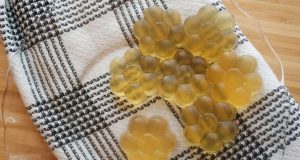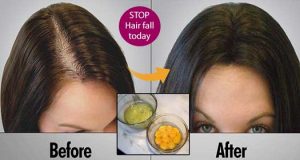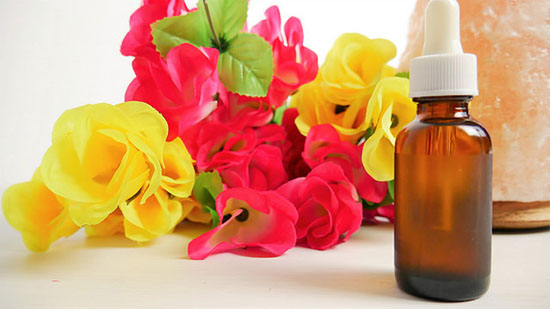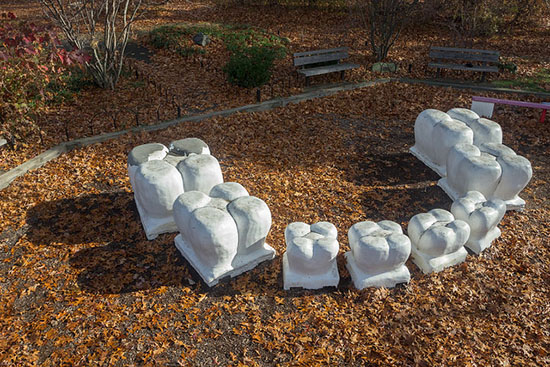We all have to stretch, no matter our preferences because our organism needs it. With stretching our blood can go to our muscles and the joints get moving and the risk of injuries as well as pain is significantly decreased. If you stretch, you will also notice your posture getting better.
Anyways, it is normal to wonder which muscles you need to stretch and if you do it right or what method is best for you.
We provide you with a bit information regarding this, and if it gets painful you will be able to change the method and avoid injuries.
These exercises should be felt in your muscles, but not as a pressure on your joints and if you do feel pressure that is a sign you are moving a bit faster than needed. While doing the stretching, focus on your breathing, feeling as if the movements are natural to your body.
Don’t concentrate on the time of performance, but focus on relaxing and resting phases. Depends which method you are using it vary from 5-30 seconds, and if you don’t feel it is the right one – simply change it!
-
Camel Pose
Most affected muscles: Rectus Abdominus and External Obliques. This one should be done mostly by people that already have developed flexibility. Sit on your heels, place your hands behind you while pushing your hips upwards and forward. Make sure you don’t apply too much pressure on your spine, and if you have neck problems do not tilt your head to the back.
-
Wide Forward Fold
Most affected muscles: adductors. Besides the adductors, you will also stretch the hamstrings while opening the hips. Bent your knees, keeping your back straight. Straighten your legs, rounding out the back and reach for the feet. Easily pull the bottoms of the feet to release the calf muscles. If you are not very flexible use a towel to reach your feet, or lie on your back, pushing your legs up to a wall.
-
Frog Pose
Most affected muscles: adductors. This one is for the groin but also putting pressure on your knees, which is why you would have to do it on a soft surface. Rest your knees and your hands and bring your knees wider and wider up to the point where you feel your muscles are well stretched. You will witness few different stretches while pushing your hips back and forward

-
Wide Side Lunge Pose
Most affected muscles: adductors. Start with placing your feet ahead of you widely, keeping the legs as straight as possible. Slowly move your hands towards the right foot and then bend your knee. Rotate the left toe upwards, sitting on your right tip. Keep the right foot on the surface.
-
Butterfly Stretch
Most affected muscles: adductors. Sit and bring the feet’s soles together, keeping your torso tall though the sit bones. Do the stretch applying pressure with your hands on your knees. To stretch the groin even more, hold the feet closer to the body. After that, keep your feet far from your hips as you slowly twist your upper body. This is for the purpose of loosening your back muscles.

-
Forearm Extensor Stretch
Most affected muscles: Forearm extensor. Pack your shoulders back down, rotate the shoulder upwards for the purpose of getting into the optimal position of stretching the muscle of the forearm. When your body is ready, apply pressure on the other hand to begin the stretch. To further develop your stretch, touch the tips of your fingers as if you are holding a tea cup.
-
Lateral Side Flexion
Most affected muscles: sternocleidomastois “SCM”. Stretch your neck as much as you can and slowly tilt your ear to your shoulder, making suere that you aren’t collapsing your cervical spine. To further develop the starch you can sit on a chair, holding the bottom of the seat. This is going to make the tension of your arm and neck continuous and this is how you can let your target be the upper traps.

-
Neck Rotation Stretch
Most affected muscles: sternocleidomastois “SCM”. Start with slow rotation of the neck, keeping your chin bit high at the same time, to isolate the SCM. To further develop the stretch, put pressure from the rotating direction with your opposite hand.
-
Neck Extension Stretch
Most affected muscles: “SCM”. Place your hands on the hips, keeping the spine long. Slowly move your head backwards.

-
Later Side Flexion of the Neck with Hand Assistance
Most affected muscles: “SCM” and upper trapezius. Check out number 7.
-
Half Kneeling Quad / Hip Flexor
Most affected muscles: psoas and quadriceps. Start with half-kneeling posture. Bring forward the right hip feeling a stretch in the front of it. Bring your foot back and squeeze your back.

-
Forearm Extensor Stretch
Most affected muscles: forearm extensor. Pack your shoulder and the back downwards. Rotate your shoulder towards outside after that, to enter the optimal position for this stretch. When you have done it, apply pressure on the other hand. Advanced stretch: touch the tips of the fingers together.
-
Lateral Shoulder Strech
Most affected muscles: side deltoid. Put pressure on your arm, keeping your arms across your body.

-
Standing Assisted Neck Flexion Stretch
Most affected muscles: trapezius. Stand straight with your feet together. Keep the spine prolonged, and set your hips back and round the upper back while you push your chin closer to your chest.
-
Lat Stretch With Spinal Traction
Most affected muscles: latissimus dorsi. Start with strong grip on a bar while you slowly lift your feet. You will feel your lats and your chest getting stretched. If you have totally lifted your feet from the surface, you will feel in in your lumbar spine. Caution: do not perform this if you have a recent injury on your shoulders.

-
Lat Stretch at the Wall
Most affected muscles: latissimus dorsi. Place both of your hands on a corner of a wall. Keeping your back straight, move your hips slowly to the side. Caution: if you have problems with the lower back do not do this stretch.
-
Deep Squat
Most affected muscles: glutes. This stretch affects your whole body. Start with placing your feet apart from each other parallel with your shoulders and start to gradually enter a deep squat. When you get to the position, bring the arms on the inside of the legs, pressuring the knees a bit, sitting into the heels and the hips. You can also do this lying with the feet up on a wall.

-
Child’s Pose
Most affected muscles: latissimus dorsi. Place your hands and knees on the floor, while slowly bringing the hips backward until you forehead touches the ground. If you like to stretch the hips better bring the knees wider, while your upper back is like an arch and you rotate the shoulders externally.
-
Standing Calf Stretch
Most affected muscles: gastrocnemius and soleus. You can do this stretch on the edge of stairs. Rotate the ankles outside and inside for active stretch.

-
Front Split
Most affected muscles: hamstring and psoas. This stretch is advanced. Start in a pose kneeling lunge. You can have a chair as a support when your hip floxors and hamstring release.
-
Seated Forward Fold
Most affected muscles: calfs and hamstrings. Sit into the seat bones, bending the knees if necessary. Keep your spine straight. You can also do this exercise lying on your back keeping your feet against a wall.

-
Single Led Forward Bend
Most affected muscles: hamstrings. Start with placing your feet in front of one another. Bring your hands on the hips and start bending, maintaining your spine straight.
-
Down Dog Variation at the Wall
Most affected muscles: pectorals and latissimus dorsi. Stand next to a wall, but make sure you can touch the wall when your body is parallel to the ground. Pivot the hips keeping the back straight and get into this position. Once you do it move the xchest forward, making arch in your upper back, stretching the lats and chest muscles. If the hamstring are tight, bend the knees.
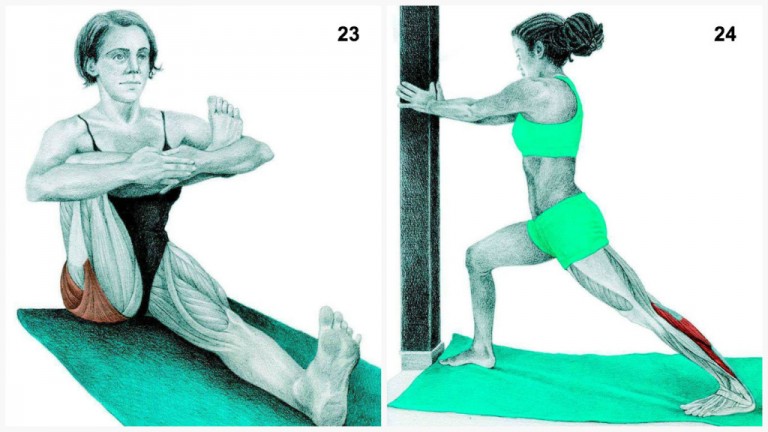
-
Seated Half King Pigeon Pose
Most affected muscles: glutes. Start in a seating position and slowly pull on of your legs to the chest, rotating the hip on the outside and maintain a straight back.
-
Supine Shoulder External Rotation
Most affected muscles: subscapularis. Start with lying on your back. Put your arm straight to the side with your elbow in a right angle. Afterwards, slowly place the back of your hand to the ground.

-
Standing Calf Stretch at the Wall
Most affected muscles: soleus and gastrocnemius. Begin in the lunge position, turning your foot outside a little bit. Slowly bring the back of the heel to the ground.
-
Lateral Flexion at the Wall
Most affected muscles: external obliques. Keep your back straight and slowly bend your hips outside. Caution: if you have issues with your lower back, do not perform the exercise.

-
Sunpine Twist
Most affected muscles: glutes and external obliques. This exercise is very good for people suffering from sciatica pain. Starting with lying on the back, bring your leg across the body, and gradually rotate your upper body to the other side. Make sure you use your breathing to open up the rib cage without applying too much pressure on the lower back. If it is too difficult for you, place the knees on top of one another.
-
Lateral Flexion with a Dowel
Most affected muscles: external obliques and latissimus dorsi. Kepp your spine prolonged and slowly push the hips out and to the side while maintaining your shoulders turned outwards. Caution: if you have lower back issues do not do this exercise.

-
Triangle Pose
Most affected muscles: external obliques. Start by taking a broad stand and your front foot straight ahead and your back foot at a 90 degrees angle. Place your hand on the front leg or on the ground and sit back into your front hip, while keeping the back straight. Rotate away from the front leg and look up to the hand in the air.
-
Chest Stretch at the Wall
Most affected muscles: pectorals. If you are a beginner, face the wall with your thumb up. Slowly turn away from the wall. You will feel your chest stretching. Be cautious not to go too far.

-
Assisted Chest Stretch
Most affected muscles: chest and latissimus dorsi. Start with lying on the ground and keep your palms facing up. Your partner should be sitting in a deep squat holding your hands. If you have shoulder impingement do not do the exercise.
-
Seated Half Pigeon Variation
Most affected muscles: anterior tibialis. Start with sitting in a such position so that you have your feet in front of you. Place one hand behind your back and rotate your hips towards the outside, placing one foot on top of your knee.

-
Standing Upper Back Extension
Most affected muscles: the teres major, rhomboid and upper trapezius muscles. Stand straight placing your feet next to each other, Reach with your arms ahead of you and interlace your finger with your hand facing ahead. Tilt your head a bit forward, and push ahead while you exhale. Keep for 10 to 15 seconds.
-
Assisted Chest Stretch
Most affected muscles: pectorals. Lye facing the floor and your palms too. Your partner should pull your hands back so that you feel a deep stretch in your muscles on your chest. Caution: if you have an injury on your shoulder, do not perform the exercise.

-
Standing Upper Trapezius Stretch
Most affected muscles: upper trapezius. Stand straight moving your hands behind your lower back. Get your right wrist with your left hand, and pull to the left as much as you can. The hands should be in the back or a bit outside of the left hip. Tilt your head to your left shoulder, feeling your neck stretching. Stay in the position for half a minute and repeat with the other side.




